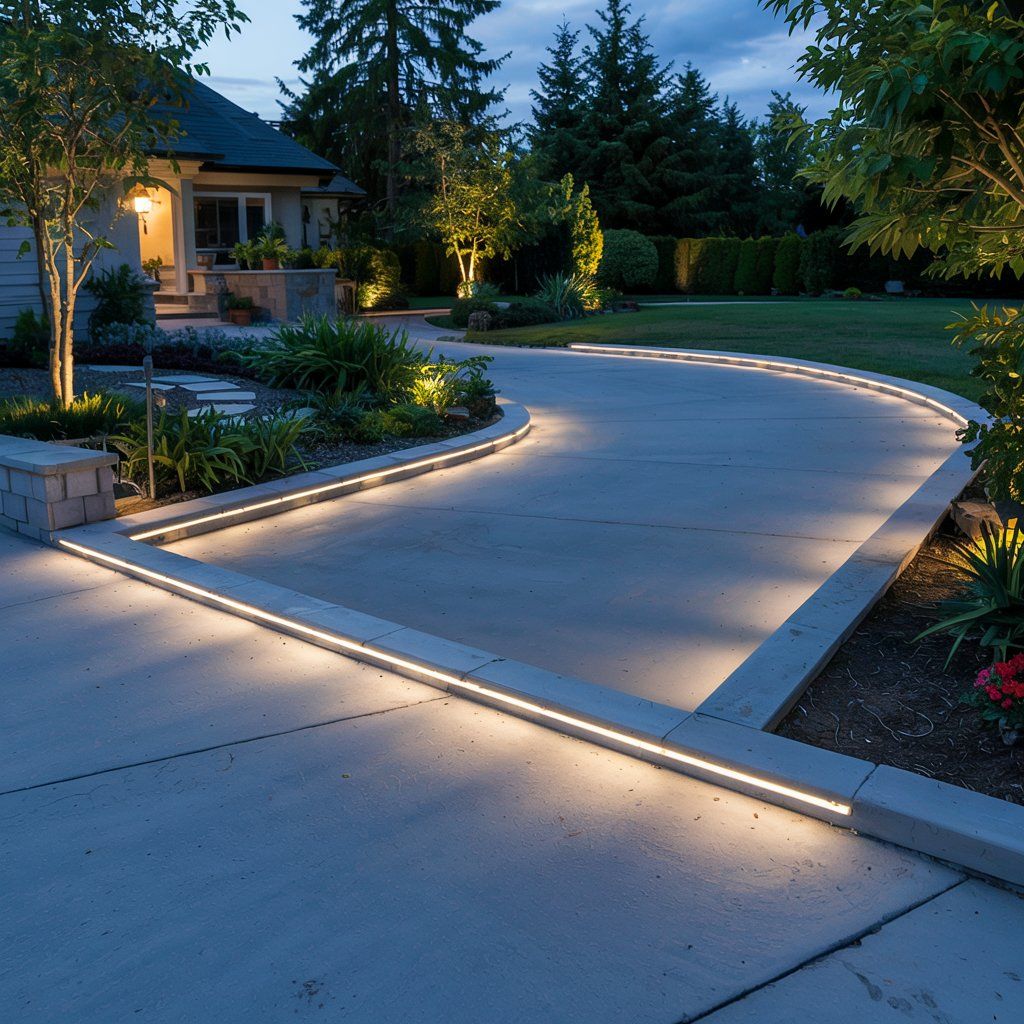Landscape Lighting
With over 20 years of experience in landscaping, Aspen Landscaping Staten Island understands that outdoor illumination not only enhances beauty but also improves safety and functionality. Landscape lighting plays a key role in highlighting architectural features and plants while extending the usability of outdoor areas after dark. Customers increasingly demand systems that combine advanced technology such as home automation with stylish designs, all while ensuring energy efficiency through low-voltage and LED solutions. The challenge is to design a lighting system that is both aesthetically pleasing and reliable, using materials—whether plastic, metal, or copper—that complement modern hardscape and softscape integration. This article provides a comprehensive overview of various outdoor lighting applications including path, walkway, backyard, garden lighting, and more. Readers will learn about benefits, installation considerations, and design strategies that transform outdoor spaces into safe, appealing, and energy-efficient environments.
Key Takeaways
- Aspen Landscaping Staten Island Offers a Wide Range of Landscape Lighting Solutions to Enhance the Beauty, Safety, and Functionality of Outdoor Spaces
- Their Expert Team Designs and Installs Custom Lighting Systems for Paths, Walkways, Backyards, Gardens, Retaining Walls, Trees, Lawns, and Driveways
- Aspen Landscaping Uses High-Quality, Energy-Efficient LED Bulbs and Durable Materials to Ensure Long-Lasting Performance and Minimal Maintenance
- The Company’s Landscape Lighting Solutions Create a Warm, Inviting Atmosphere That Extends the Enjoyment of Outdoor Living Spaces Into the Evening Hours
- Aspen Landscaping’s Strategically Placed Lighting Fixtures Highlight the Best Features of the Landscape While Providing Ample Illumination for Safety and Security

Path Lighting
Path lighting defines safe and inviting pedestrian routes through landscaped areas. Typically low-voltage fixtures mounted along garden paths, driveways, or walkways, they cast gentle pools of light on adjacent surfaces. Made from durable materials like stainless-steel or copper, these lights not only reduce tripping hazards on uneven surfaces but also enhance natural textures found in stone, gravel, or wood.In groups, path lights provide an even and structured illumination. Modern systems often include home automation features such as remote control and scheduled operation, with sensors that adjust brightness based on daylight. In one installation, path lighting transformed a residential garden by casting a soft, welcoming glow that enhanced both functionality and style. Customers can choose from a range of traditional or contemporary designs to complement their landscapes.
Walkway Lighting
Walkway lighting creates safe passages by guiding foot traffic through outdoor spaces. Typically installed flush with or slightly above the ground, these lights combine functionality with decorative appeal through narrow profiles and directional beams designed to focus light along the intended path without glare.Ideal for residential settings, walkway lights prevent accidents while adding depth and contrast to the landscape. Recent LED advancements have improved efficiency and reduced maintenance costs. Many systems now include motion sensors or dimming features to suit varying conditions. In one case, a row of strategically placed walkway lights dramatically enhanced the curb appeal of a spacious driveway and improved nighttime visibility.
Backyard Lighting
Backyard lighting transforms private outdoor spaces into extensions of home living areas. By illuminating key features such as patios, decks, and seating areas, these systems create a warm and welcoming ambiance for family gatherings or quiet evenings.Effective backyard lighting designs incorporate ambient, task, and accent lighting. For example, recessed lights, wall sconces, and spotlights can be combined to highlight a water fountain or mature trees. Low-voltage LED fixtures are common due to their energy efficiency and longevity, and integration with smart home automation allows homeowners to adjust brightness or colors for different moods or events. In one project, dimmable LED fixtures connected to a central panel converted a quiet retreat into an inviting party venue with the simple push of a button.
Garden Lighting
Garden lighting focuses on accentuating natural and architectural features within a garden setting. By using spotlights, well-lights, and uplights, strategic illumination draws attention to plants, sculptures, and water features, creating dramatic focal points that change throughout the day. The fixtures chosen for garden lighting must harmonize with natural elements. Modern LED garden lights are prized for replicating natural warmth and delivering energy efficiency. A layered lighting approach is common, where accent lights emphasize specific features, ambient lights create a general glow, and task lights help around work areas. In one estate garden, a well-planned design reduced energy consumption while producing a visually stunning nocturnal display. Automation integration ensures lights adapt to sunset times, bolstering both functionality and security.
Outdoor Yard Lamps
Outdoor yard lamps offer versatile illumination and decorative styling for yards. These freestanding units can be positioned to light large areas or near focal points like sculptures and seating areas. While many evoke classic lantern designs, modern versions incorporate sleek elements, energy-efficient LED bulbs, and remote operation features. Beyond simple lighting, yard lamps set the overall mood of an outdoor space. Often equipped with adjustable brightness or dusk-activated sensors, they ensure proper illumination without wasting energy. Their strategic placement enhances open areas such as lawns or patios, guiding visitors safely. One upscale project used yard lamps around a central courtyard to achieve a layered effect that amplified both the architectural framing and surrounding greenery.
Retaining Wall Lighting
Retaining wall lighting is crucial for both safety and aesthetics in outdoor landscapes. Mounted on or near retaining walls, these lights illuminate steps and pathways while accentuating architectural details. They are particularly valuable in areas with sloped landscapes, revealing irregular surfaces during low-light conditions. Modern retaining wall lighting usually utilizes low-voltage LED fixtures that cast broad or focused beams to enhance the wall’s texture. Many systems now feature dimming or color-changing controls to tailor the ambiance. In a commercial setting, such lighting not only improved pedestrian safety by highlighting level transitions but also contributed to a modern aesthetic by complementing the building’s design. Choosing fixtures that blend with materials like stone, brick, or concrete results in a cohesive, visually appealing look.
Up lighting For Trees
Uplighting for trees dramatically highlights the natural beauty and stature of mature trees by casting upward beams from the base. This technique creates striking silhouettes and emphasizes the intricate patterns of branches and leaves, adding visual depth to outdoor spaces.By illuminating trees from below, uplighting creates a dynamic interplay of light and shadow that transforms ordinary yards into captivating nocturnal scenes. Often integrated with dimmable LED systems, the brightness can be adjusted according to time of day or design needs, enhancing energy efficiency. In one public park, uplighting showcased a centuries-old oak by emphasizing its sprawling canopy, creating an enchanting atmosphere while carefully minimizing glare and light spill.
Lawn Lighting
Lawn lighting provides soft, even illumination across expansive grass areas, enhancing nighttime visibility while preserving the natural beauty of the landscape. Properly installed, these lights accentuate yard contours and landscaping features, creating an inviting atmosphere for outdoor gatherings.A variety of fixtures including spotlights, recessed lights, and low-voltage LED systems are used to achieve balanced illumination without harsh shadows. The energy-efficient nature of modern LED technology reduces power consumption while ensuring bright, long-lasting performance. In one residential application, a thoughtful arrangement of lawn lights not only improved safety but also significantly boosted curb appeal. Integration with smart controls further allows homeowners to schedule light operation based on dusk, maximizing efficiency.
Ground Lights
Ground lights are discreet fixtures installed directly into the landscape along walkways, driveways, or garden beds. They cast upward or outward beams to subtly highlight key features without disrupting the natural scenery.Manufactured from weather-resistant materials such as stainless-steel, aluminum, or high-grade plastics, ground lights are designed to endure harsh conditions. Their protective covers and specialized lenses ensure even light distribution while preventing glare. Adjustable settings allow for precise control of beam direction and intensity, tailoring the lighting scheme to enhance landscaped features. In a commercial project, ground lights outlined flower beds and water features, adding depth and dimension to the nighttime view while maintaining pedestrian safety. Often integrated into automation systems, they adapt to ambient light conditions, offering both functionality and energy savings.
Driveway Lighting
Driveway lighting is a key aspect of hardscape design, combining safety, security, and visual appeal at property entrances. By illuminating driveways, these fixtures create a welcoming ambiance and deter potential intruders. Installed along the sides or overhead, they guide vehicles and pedestrians while serving as striking architectural accents.
Modern driveway lighting includes wall-mounted fixtures, bollard lights, and integrated LED path lights that operate on low voltage for cost-effective energy use. Many systems incorporate smart technology for remote adjustment of brightness and color temperature. In one suburban installation, driveway lighting seamlessly integrated with home automation enhanced both practical illumination and decorative flair. Durable materials such as powder-coated metals and weather-resistant plastics ensure long-term performance despite outdoor exposure.
| Lighting Type | Key Feature | Primary Benefit | Material Options |
| Path Lighting | Low-voltage, directional beams | Enhances safety and ambience | Stainless steel, copper |
| Walkway Lighting | Flush-mounted fixtures | Guides foot traffic effectively | Metal, weather-resistant |
| Backyard Lighting | Combination of ambient and task lights | Extends outdoor usability | LED, smart-controlled |
| Garden Lighting | Spot and well-lit fixtures | Highlights natural features | Concrete, LED |
| Driveway Lighting | Bollard and wall-mounted designs | Enhances security and curb appeal | Powder-coated metal, LED |
Before exploring the next section, consider the above table for a quick comparison of various lighting features and benefits. It shows how thoughtful selection can vastly improve both the visual and functional quality of outdoor spaces.
